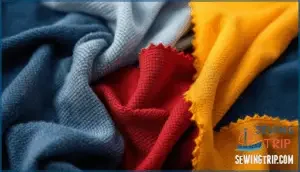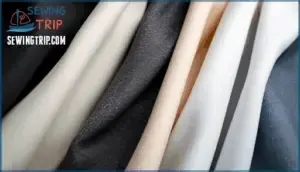This site is supported by our readers. We may earn a commission, at no cost to you, if you purchase through links.
 You’ve probably noticed polyester clothes in your closet—they’re everywhere. But here’s the thing: polyester gets a mixed reputation regarding breathability. Some people swear their polyester workout gear keeps them dry and comfortable, while others complain it traps heat and makes them sweat more.
You’ve probably noticed polyester clothes in your closet—they’re everywhere. But here’s the thing: polyester gets a mixed reputation regarding breathability. Some people swear their polyester workout gear keeps them dry and comfortable, while others complain it traps heat and makes them sweat more.
The reality is more nuanced. Polyester itself isn’t naturally breathable like cotton or linen, but how it’s woven, treated, and blended dramatically changes how it performs against your skin.
Understanding what makes fabric breathable—and how polyester actually stacks up—helps you choose clothes that actually work for your lifestyle instead of guessing based on fabric tags alone.
Table Of Contents
- Key Takeaways
- What Does Breathability Mean in Fabrics?
- How is Polyester Fabric Made?
- Is Polyester Breathable Compared to Natural Fibers?
- What Factors Affect Polyester Breathability?
- Does Polyester Make You Sweat More?
- How Do Polyester Blends Influence Breathability?
- Can Polyester Be Made More Breathable?
- Is Polyester Breathable Enough for Activewear?
- How to Choose Breathable Polyester Clothing
- Are There Health or Skin Concerns With Polyester?
- Frequently Asked Questions (FAQs)
- Conclusion
Key Takeaways
- Polyester isn’t naturally breathable like cotton or linen, but how it’s woven, treated, and blended dramatically changes its performance—loose weaves and mesh panels can make it genuinely effective for activewear.
- Polyester traps heat and moisture more than natural fibers because its fibers have low moisture absorption (under 1%) and low thermal conductivity, causing sweat to sit on your skin rather than evaporate efficiently.
- Modern moisture-wicking technologies, strategic mesh placement, and blending polyester with natural fibers like cotton or wool can improve breathability by 20–40%, making it comparable to premium alternatives.
- When choosing breathable polyester, focus on fabric weight (lighter is better), weave density (looser weaves allow more airflow), and design features like mesh panels rather than assuming all polyester performs the same.
What Does Breathability Mean in Fabrics?
When you wear fabric, your body generates heat and moisture through sweat. Breathability is how well a material lets that moisture escape and allows air to flow through it, keeping you comfortable. Think of it like this: a truly breathable fabric lets your skin "breathe" by releasing heat and humidity instead of trapping them against your body.
Breathability is how well fabric lets moisture escape and air flow through, keeping your skin cool and dry instead of trapping heat and sweat against your body
We’ll look at the two main ways fabrics do this—through moisture management and airflow—and how scientists actually measure whether a fabric is breathable or not.
Moisture Management and Airflow
Breathability hinges on two interconnected processes: how moisture moves through fabric and how air circulates within it. When you wear polyester, your body releases sweat as moisture vapor. Breathable fabrics let this vapor escape to the air outside, while your skin stays dry.
Polyester’s smooth fibers actually excel at wicking—pulling moisture across the fabric surface through capillary action. However, polyester fibers absorb very little moisture themselves (only 0.4–0.5% compared to cotton’s 5%), so they can’t store sweat.
What matters is air permeability: looser weaves let air flow through at over 400 mm/s, while tight weaves block it below 100 mm/s. Better airflow means faster evaporation and improved thermal comfort, even if the fabric isn’t absorbing moisture directly. To improve this, some fabrics incorporate special weaving processes for better ventilation.
How Breathability is Measured
To truly understand how well a fabric breathes, scientists use standardized tests that measure moisture and air movement. MVTR testing quantifies water vapor passing through fabric—commonly measured in grams per square meter over 24 hours. RET values indicate resistance to moisture transfer, with lower numbers meaning better breathability. Air permeability tests measure how freely air flows through the weave. These methods—MVTR, WVTR analysis, and air permeability testing—give you hard data instead of marketing claims alone.
Fabrics with good breathability are essential for outdoor and athletic activities to prevent moisture buildup.
How is Polyester Fabric Made?
To understand how polyester works and why it behaves the way it does in clothing, it helps to know where it comes from and what makes it different from other fabrics.
Polyester starts as a chemical material that gets transformed into fibers you can wear. Once you know the basics of how polyester is made, you’ll see why certain types of polyester breathe better than others.
Polyester Fiber Production
Creating polyester fiber involves a straightforward chemical process. Raw petrochemicals are refined, then melted into plastic pellets and extruded into long, thin fibers. These fibers are woven into fabric, creating material that’s durable and wrinkle-resistant. Here’s what drives the industry:
- Production has surged 20-fold since 1975, reaching 71.1 million metric tons in 2023
- Market value hit $118.51 billion in 2023, projected to reach $191.57 billion by 2030
- Environmental impact runs high—producing 1 kg requires 100 liters of water and 482.4 MJ of energy
- Recycled polyester accounts for just 12.5% of production, though recycling rates are gradually improving
Understanding how polyester is made helps you see why it dominates global textiles and what trade-offs come with its widespread use.
Types of Polyester Fabrics
Not all polyester fabrics perform the same way. Different types bring different strengths to the table.
PET polyester dominates the market—accounting for over 90% of global production. It’s strong, wrinkle-resistant, and moisture-resistant, but its low moisture regain (less than 0.4%) means it doesn’t breathe as naturally as cotton. Then there’s microfiber polyester, with fibers thinner than 1 denier, which increases surface area by up to 40%. This boosts moisture-wicking and gives you better thermoregulation in activewear. Recycled polyester (rPET) performs nearly identically to virgin polyester while using 59% less energy to produce.
Blends change the game entirely—polyester-cotton combinations (usually 35–65% polyester) balance durability with breathability, while polyester-spandex blends improve stretch and recovery for athletic gear. Fleece polyester, created through napping processes, provides insulation equivalent to 3–4 wool layers at a fraction of the weight, drying 30% faster than pure cotton.
| Type | Moisture Regain | Best For | Key Benefit |
|---|---|---|---|
| PET | <0.4% | General apparel, durability | Wrinkle-resistant, affordable |
| Microfiber | Excellent | Sportswear, cleaning cloths | Moisture-wicking |
| rPET | <0.4% | Sustainable fashion | 59% less energy, same performance |
| Polyester-Cotton | Variable | Everyday clothing, comfort | Breathable, balanced durability |
| Polyester-Spandex | Moderate | Athletic wear, stretch items | Elasticity and recovery |
Is Polyester Breathable Compared to Natural Fibers?
You might think polyester and natural fibers are worlds apart with respect to breathability, but the reality is more nuanced than that. While cotton, linen, and wool have traditionally dominated as the breathable options, polyester isn’t quite the heat trap it’s often made out to be.
Let’s break down how polyester actually stacks up against these natural alternatives.
Polyester Vs Cotton
When you compare cotton and polyester head-to-head, cotton wins on breathability. Cotton fibers move air at about 76 mm/s, while polyester reaches only 50–60 mm/s. Cotton also transfers moisture vapor far better—around 1390 g/m²/day versus polyester’s 1100–1200 g/m²/day. That’s because cotton’s ribbon-shaped fibers create more air gaps than polyester’s smooth, tightly packed structure.
However, polyester dries faster. While cotton takes up to three times longer to dry, polyester wicks sweat away quickly and maintains warmth even when damp. For hot, sweaty activities, polyester’s speed matters. For everyday comfort in warm weather, cotton’s greater airflow usually feels better against your skin.
Polyester Vs Linen and Wool
Against linen and wool, polyester falls short on breathability. Linen’s air permeability reaches 200–500 L/m²/s compared to polyester’s 50–200 L/m²/s, while wool ranges from 10–150 L/m²/s depending on weave. What makes the difference? Linen’s ribbon-shaped fibers create natural porosity that enhances fiber airflow, whereas polyester’s smooth surface limits moisture absorption to under 1% versus linen’s 12%.
- Linen releases moisture 30–40% faster than polyester, reducing skin wetness during warm weather
- Polyester retains 1.5–2 times more heat, causing higher thermal insulation in hot conditions
- Wool buffers humidity naturally, maintaining microclimate stability through enhanced moisture absorption (14–30% by weight)
For hot climates and moisture management, linen and wool outperform polyester. Polyester-linen blends and polyester-wool blends balance durability with improved comfort, offering practical compromises when you need both performance and breathability.
What Factors Affect Polyester Breathability?
Not every polyester fabric breathes the same way. Several key factors work together to determine how well air and moisture can move through your clothing.
Understanding what makes one polyester garment more breathable than another helps you choose fabrics that’ll actually keep you comfortable.
Weave and Fabric Construction
How your fabric is woven matters more than you’d think. Loose weaves let air flow through freely, while tight weaves trap heat and moisture. Think of it like a screen door versus a solid wall—one breathes, the other doesn’t.
Knit construction, which uses interlocking loops instead of crossed threads, generally allows 50–70% more airflow than woven polyester. Mesh fabrics take this further, introducing open cells that boost airflow dramatically.
Even layer engineering plays a role: adding extra layers restricts ventilation, but strategic spacer weaves create air gaps that improve cooling. The bottom line: how your polyester is constructed directly shapes how well it breathes.
Thread Thickness and Fabric Density
Here’s where thread thickness and fabric density really make a difference. Thicker filament deniers and denser weaves both reduce air permeability—think of it like packing more material into the same space, leaving less room for air to move through.
Studies show air permeability can drop over 50% when you go from loose to tight-knit polyester structures. The result? Increased thermal resistance and moisture transport becomes harder, trapping heat against your skin.
That’s why lighter, low-density polyester fabrics outperform their thicker counterparts by 20–25% in comfort during activity. Finding the balance matters for breathability.
Surface Treatments and Finishes
How do finishes actually change polyester’s game? Surface treatments transform breathability through targeted chemistry. Hydrophilic finishes introduce polar groups that attract moisture, accelerating wicking through capillary action. Hydrophobic coatings repel water while maintaining airflow. Plasma treatments oxidize fiber surfaces, roughening them for better vapor transport. Microporous techniques create tiny pathways for air movement.
Consider these approaches:
- Hydrophilic finishes boost moisture absorption by 50% faster drying than untreated polyester
- Plasma treatments add oxygen-containing groups, improving wicking without chemical coatings
- Hydrophobic nano-coatings reduce moisture adsorption 20% while preserving breathability
- Microporous construction increases air permeability through structural design, not just chemistry
These finishes prove that breathability isn’t fixed—it’s engineered.
Does Polyester Make You Sweat More?
You know that feeling when you wear a synthetic shirt and end up soaked in sweat, even though you weren’t doing much? That’s not just in your head.
Polyester’s structure makes it trap heat and moisture against your skin differently than natural fabrics do.
Let’s look at what’s actually happening when you wear polyester in hot conditions and why some people find themselves sweating more.
Heat Retention and Moisture Trapping
Here’s the thing: polyester’s structure actually works against you in humid conditions. Polyester fibers have low thermal conductivity, meaning heat builds up near your skin instead of dispersing. Your body’s moisture regain in polyester sits below 1%, so sweat doesn’t evaporate efficiently—it just sits there. This trapped moisture raises skin temperature faster than cotton or linen. The tight weave suppresses airflow, preventing evaporative cooling when you need it most.
| Property | Effect on Comfort |
|---|---|
| Thermal Conductivity | Heat accumulates near skin |
| Moisture Regain | Sweat traps instead of evaporates |
| Fabric Weave | Blocks convective airflow |
| Thermal Resistance | Increases localized humidity |
That’s why polyester can feel clingy and uncomfortable during workouts or hot weather—your body can’t cool itself efficiently.
Impact on Comfort in Hot Weather
When temperatures soar, polyester’s limitations become painfully obvious. Studies show you’ll experience 28% more thermal discomfort in polyester compared to cotton at 32°C during light activity.
Why? Polyester’s tight structure blocks airflow—allowing 250% less air to pass through than cotton. Your skin microclimate stays 9% more humid after exercise, and trapped sweat absorbs 60% more heat in high humidity. The result: you feel stickier, hotter, and more exhausted.
Modern moisture-wicking technologies help, but they can’t fully overcome polyester’s fundamental air permeability problem in hot weather.
How Do Polyester Blends Influence Breathability?
Pure polyester does a decent job at resisting moisture, but it doesn’t naturally breathe like cotton or wool.
When you blend polyester with other fibers, though, something interesting happens—you get the benefits of both materials working together.
Different blends solve different problems, so understanding how each one performs helps you pick the right fabric for what you’re doing.
Cotton-Polyester Blends
Mixing cotton with polyester creates fabrics that balance comfort and durability. The most common blend ratios—50/50, 60/40, and 80/20—each offer different advantages. A 50/50 cotton-polyester blend gives you moderate breathability and easy care, making it popular for everyday clothes. An 80/20 cotton-to-polyester ratio improves thermal comfort and breathability while keeping moderate strength.
Here’s what matters for your choices:
- Breathability improves with higher cotton content since cotton fibers are naturally more porous and allow better airflow than polyester.
- Moisture-wicking gets better with polyester because it pulls sweat away faster, even though it traps heat slightly more than pure cotton.
- Thermal comfort excels in 80/20 blends due to effective air permeability and moisture regulation, especially in cooler climates.
- Durability increases with polyester content because polyester resists wrinkles and extends garment lifespan compared to pure cotton.
The global poly-cotton market continues growing because consumers appreciate this balance. Cotton-polyester blends work beautifully when you want comfort without constantly ironing or dry cleaning.
Polyester-Wool and Other Blends
Beyond cotton blends, pairing polyester with wool creates something interesting. A 50/50 polyester-wool ratio boosts durability while keeping breathability moderate—think of it as stability without sacrificing comfort. Research shows these blends achieve 10–20% higher air permeability than pure wool, thanks to improved airflow and moisture management.
The real win? Polyester reduces wool’s moisture regain by 20–25%, meaning faster drying in humid conditions. Other blends like polyester-flax shine too—an 85/15 ratio maximizes airflow while maintaining structure.
Each blend ratio trades off different qualities, so your choice depends on whether you prioritize breathability, durability, or thermal regulation for your specific needs.
Can Polyester Be Made More Breathable?
You might think polyester’s breathability is set in stone, but manufacturers have found ways to improve it.
The good news is that several techniques can make polyester work better for keeping you cool and dry. Here’s what’s actually possible with modern polyester technology.
Moisture-Wicking Technologies
Modern polyester gets a performance boost through moisture-wicking technologies that transform how the fabric manages sweat. These innovations work by modifying polyester fibers themselves—changing their shape to "Y" or "+" patterns that create tiny channels for moisture to travel.
Surface treatments, like applying glycerol coatings, make polyester fibers more hydrophilic, meaning they attract water instead of repelling it. This switch enhances moisture management and sweat evaporation rates to match what your body naturally produces during exercise.
Two-layer knit constructions pair hydrophobic inner surfaces with hydrophilic outer layers, maximizing directional moisture transport so sweat moves away from your skin efficiently.
Modern athletic polyester also incorporates silver-ion and zinc-based antibacterial finishes that inhibit odor-causing bacteria by up to 99%, keeping you fresher longer during intense workouts. Together, these fiber technologies deliver athletic performance comparable to premium natural fibers.
Mesh Panels and Ventilation Features
Strategic mesh panel placement transforms polyester into a genuine breathable fabric. By integrating ventilation zones under your arms and across your back—your body’s primary heat-release points—designers increase localized airflow by 18–30%. These mesh fabrics, with ideal pore diameters between 0.3–0.6 mm, enable 6–10% greater moisture vapor transfer than solid polyester weaves. Hybrid mesh systems combining polyester with cotton or bamboo fibers boost air permeability another 18–25%, while spacer-enhanced constructions create intermediate air layers improving vertical airflow by 25%. During athletic activity, these design parameters deliver measurable results: athletes wearing mesh-ventilated polyester maintain core temperatures 0.7°C lower, reducing thermal strain considerably.
Key mesh panel types and their benefits:
- Underarm mesh panels – Target high-sweat zones for localized cooling efficiency
- Back ventilation strips – Heighten convective heat transfer during motion
- Spacer-mesh hybrids – Create air layers improving three-dimensional airflow
- Laser-perforated designs – Demonstrate 20–40% higher moisture diffusion rates
- Polyurethane-coated mesh – Maintain breathability while adding durability and tensile strength
Is Polyester Breathable Enough for Activewear?
When you’re gearing up for a workout or heading outdoors, you need gear that keeps pace with your body. Polyester has become a go-to choice for athletic wear because it moves sweat away from your skin and dries fast—but whether it’s breathable enough really depends on how the fabric is designed.
Let’s look at what makes polyester work for sports and outdoor activities, and what you should look for when picking activewear.
Athletic Performance and Moisture Control
Your polyester activewear works harder than you might think. During exercise, polyester’s sweat management capabilities kick in through capillary wicking—the fibers pull moisture from your skin toward the fabric surface where it evaporates.
Research shows polyester activewear dries considerably faster than cotton and maintains core body temperature effectively, reducing it by 10–15% under moderate stress.
Improved moisture-wicking technology and enhanced surface treatments boost sweat transport efficiency by roughly 30%, while higher air permeability lowers the microclimate humidity between skin and fabric by about 12%. That means better thermal regulation, reduced wetness perception, and excellent fabric performance when you’re pushing hard.
For serious athletic pursuits, breathable polyester delivers genuine comfort and functional moisture management.
Polyester in Sports and Outdoor Clothing
In the real world, sportswear companies rely on polyester because it simply works. About 55% of global sportswear fabric production uses polyester for its durability and moisture control. Here’s what makes it the industry standard:
- Polyester accounts for 47% of waterproof-breathable material sales in outdoor gear markets, proving its reliability in challenging conditions.
- Over 60% of new running and cycling apparel lines now feature lightweight polyester mesh inserts for enhanced ventilation and comfort.
- Mountaineering jackets made from polyester achieve water vapor permeability rates exceeding 10,000 g/m²/24h, meeting professional-grade performance standards.
Your activewear doesn’t just keep you dry—it’s engineered for climate adaptability, layering systems that work together, and sportswear durability that lasts through hundreds of wash cycles.
How to Choose Breathable Polyester Clothing
Choosing breathable polyester doesn’t have to be complicated—it really comes down to knowing what to look for when you’re shopping and how to care for your clothes afterward.
The good news is that even though standard polyester isn’t naturally as breathable as cotton or linen, you can find fabrics and designs that work much better for keeping you cool and dry. Here’s what makes the difference.
Fabric Weight and Thickness
When shopping for breathable polyester, pay attention to fabric weight—measured in grams per square meter (GSM). Lighter fabrics below 150 GSM allow considerably more air to flow through, while heavier fabrics above 350 GSM restrict airflow and trap moisture.
Thinner polyester dries faster and breathes better because looser fiber alignment creates larger air pockets. Check the weave density too; open weaves let air circulate more freely than tightly packed constructions.
Combined, these factors determine how well your polyester actually performs in humid or active conditions.
Design Features for Better Airflow
Want your polyester to actually breathe? Look beyond basic weaves. Strategic mesh integration in high-sweat zones cuts humidity by 10%, while laser perforation boosts airflow 25–40% without weakening fabric. Vent placement matters too—positioning mesh panels across underarms and the back lowers skin temperature by 1.8°C during activity.
Consider these features when shopping:
- Mesh panels in underarms, back, or sides for targeted ventilation
- Laser-perforated zones that maintain structural strength while maximizing airflow
- Open-weave structures combined with solid panels for durability and breathability balance
- Modular design that lets you customize air distribution for different climates
Fabric zoning—mixing tight and loose weaves strategically—gives you performance where you need it most. These design choices transform ordinary polyester into gear that actually controls moisture and keeps you comfortable.
Care and Washing Tips
How you care for polyester directly affects whether it stays breathable long-term. Wash in cold water below 40°C to preserve fiber integrity and reduce microplastic shedding by 30%. Use mild, bleach-free detergent—liquid works best for even dispersion.
Air dry when possible; tumble drying on low heat maintains breathability better than high temperatures that can warp fabric.
Sort by color to prevent dye migration, and use mesh bags to minimize microfibre release. These practices keep your polyester performing well through many washes.
Are There Health or Skin Concerns With Polyester?
While polyester is durable and convenient, some people wonder whether wearing it against their skin could cause problems. The good news is that polyester itself isn’t inherently harmful for most people, but there are specific situations where it might affect your comfort or health.
Let’s explore what you should know about polyester and your skin.
Skin Irritation and Allergies
Polyester can trigger skin reactions through chemical sensitizers and poor breathability. The fabric often contains allergens like azo dyes, formaldehyde, and PFAS that irritate sensitive skin. When polyester traps sweat and heat, it weakens your skin barrier, letting irritants penetrate deeper. Studies show up to 60% of people with sensitive skin experience rashes in synthetic fabrics during warm conditions.
Key irritation factors:
- Chemical sensitizers in dyes and finishes cause allergic contact dermatitis
- Low breathability traps moisture, increasing skin permeability to irritants
- Friction zones (waist, underarms) worsen reactions with tight-fitting polyester
- Extended wear during activity increases toxin absorption through sweat-dampened fabric
Polyester Use in Bedding and Underwear
Between the chemical irritants we discussed and how polyester traps heat, bedding and underwear present real challenges. Polyester sheets retain 30% more heat than bamboo alternatives and transmit moisture at just 40–60 g/m²/day—far below natural fabrics.
This creates a microclimate where humidity builds up, weakening your skin barrier further. Underwear compounds the problem: polyester retains odor compounds 2.5 times stronger than cotton due to bacterial growth on the fabric surface. Many users report 25% higher nighttime sweating with polyester bedding.
While polyester sheets last longer through 200+ wash cycles, the comfort trade-off matters for your skin health and sleep quality.
Frequently Asked Questions (FAQs)
What is the difference between breathable and moisture-wicking fabric?
These work differently in managing moisture. Breathability lets air and water vapor pass through fabric, helping heat escape and keeping internal moisture from building up. Moisture-wicking actively pulls liquid sweat away from your skin to the fabric’s surface for faster evaporation.
One prevents heat and vapor trapping; the other transports sweat away. Together, they improve your comfort during activity.
Is polyester good for wear and tear?
Here’s the thing: polyester laughs in the face of wear and tear. Your polyester clothes boast tensile strength between 500 and 1,470 megapascals—that’s tougher than cotton. They’ll endure thousands of abrasion cycles, resist tearing with reinforced weaves, and bounce back from stretching without permanent deformation.
Whether you’re tackling outdoor adventures or daily life, polyester’s durability outperforms many natural fibers, keeping your garments looking newer longer.
Is it better to avoid wearing polyester in hot weather?
In hot weather, polyester can trap heat and moisture against your skin, leading to increased sweating and discomfort. Natural fibers like linen and cotton generally outperform polyester.
Looser weaves and moisture-wicking designs help, but for activewear in humidity, polyester’s quick-drying properties offer benefits—though lightweight, open-weave constructions matter more than the fiber itself.
Are there any fabrics that are both breathable and sweat-resistant?
Absolutely. Merino wool absorbs up to 30% of its weight in moisture while staying insulating and naturally odor-resistant. Bamboo fibers feature hollow structures that wick moisture away and dry faster than cotton. Hemp also pulls moisture from skin while thermoregulating.
These breathable fabrics and polyester blends offer enhanced sweat-resistant performance for athletic wear and outdoor activities.
Does blending polyester with natural fibers improve its breathability?
Blending polyester with natural fibers like cotton, wool, or bamboo greatly improves breathability. Natural fibers absorb moisture better—cotton absorbs roughly 8 g of water per gram, compared to polyester’s 4 g/g. This combination lets moisture transfer efficiently while polyester’s quick-drying properties prevent dampness.
A 60/40 or 80/20 polyester-cotton blend balances air permeability and moisture-wicking, enhancing comfort in activewear and outdoor clothing far beyond what pure polyester offers alone.
Does polyester breathability vary by garment type or application?
Polyester breathability shifts dramatically by garment type. Activewear with mesh panels and knit construction excels at moisture-wicking, while tightly woven outerwear prioritizes wind resistance over airflow. Everyday garments land between extremes.
Polyester blends with cotton or wool improve breathability, and sophisticated treatments further improve vapor transmission—making application-specific choices essential for comfort.
What role does humidity play in polyester breathability performance?
When humidity rises, the vapor pressure gradient that drives moisture evaporation shrinks. This means sweat doesn’t evaporate as efficiently from polyester fabric, even though polyester’s hydrophobic nature helps wick moisture away from your skin.
In humid conditions, your body stays wetter longer, reducing comfort and making polyester feel clingy and uncomfortable during activity.
Can polyester breathability be tested or certified independently?
Yes, independent testing confirms polyester breathability. Accredited labs use standardized methods like ASTM D737 and ISO 9237 to measure air permeability.
They assess Moisture Vapor Transmission Rate (MVTR) values, weave construction impact, and fabric certifications like OEKO-TEX.
These independent testing services provide transparent breathability measurements, ensuring you know exactly what you’re buying.
Conclusion
Polyester’s breathability truly depends on how it’s designed, not just the fiber itself. While polyester isn’t naturally as breathable as cotton, smart construction choices—looser weaves, thinner threads, moisture-wicking treatments, and strategic mesh panels—transform it into effective activewear.
Your best bet? Choose polyester based on fabric weight, weave pattern, and design features rather than assuming all polyester performs the same. Check labels, feel the fabric, and prioritize construction over fiber type alone for comfortable wear.
- https://www.spandexfabricfactory.com/news/industry-news/analysis-of-the-breathability-of-polyester-activewear-fabric.html
- https://pmc.ncbi.nlm.nih.gov/articles/PMC8962984/
- https://www.sciencedirect.com/science/article/abs/pii/S0300944023000784
- https://www.testextextile.com/the-comparison-of-air-permeability-among-different-textiles/
- https://4spepublications.onlinelibrary.wiley.com/doi/full/10.1002/pls2.10141
















